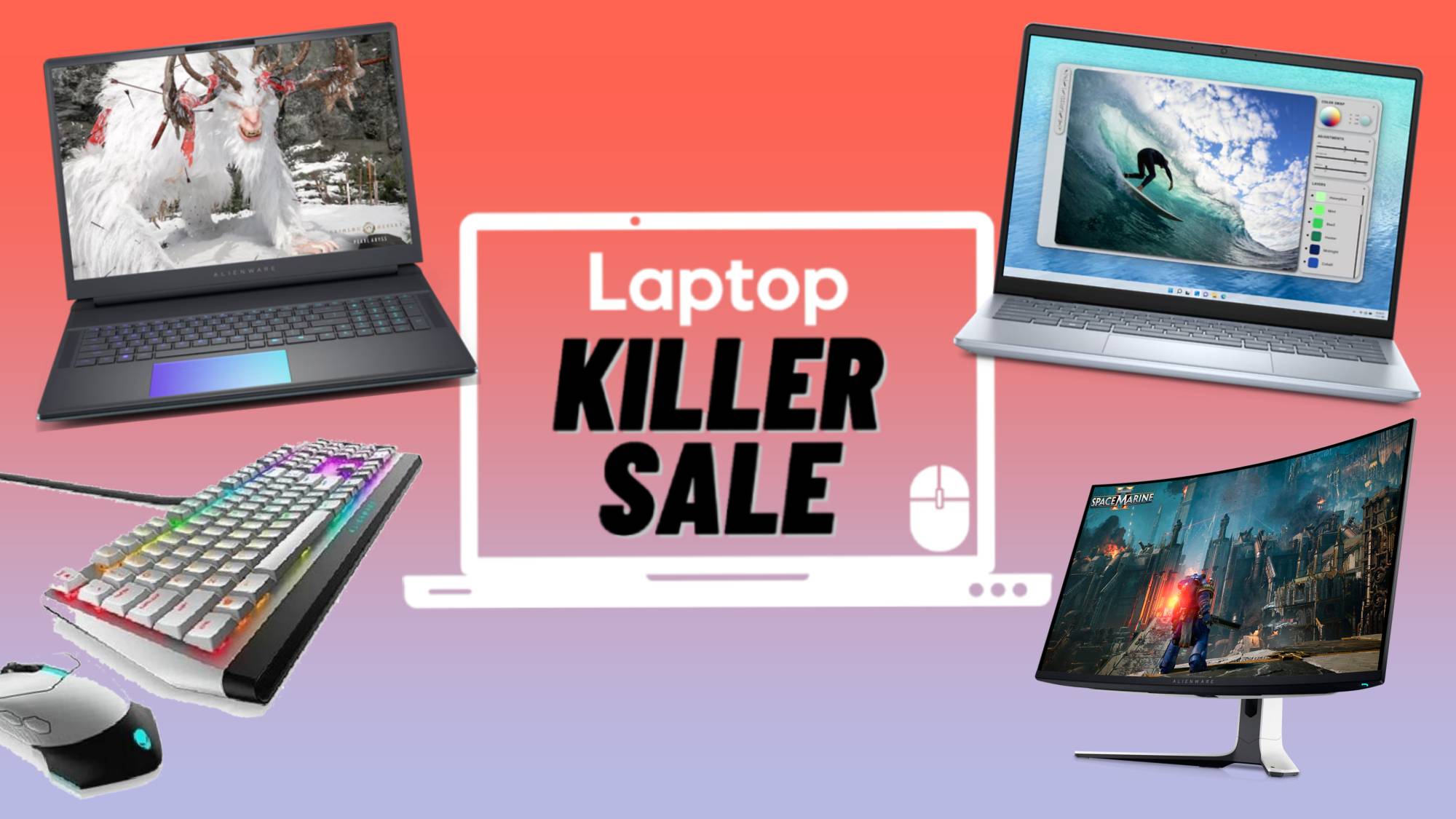Laptop Mag Verdict
Apple's latest smart phone raises the bar for displays, camera quality, and two-way video chat in a remarkably slim and sexy design.
Pros
- +
Incredibly sharp display
- +
Best camera/camcorder available on smart phone
- +
Gorgeous industrial design
- +
Intuitive video chat
- +
Longer battery life
Cons
- -
No mobile hotspot feature
- -
Lacks HDMI output
- -
Data plan not unlimited
- -
Signal degrades when you cover bottom left corner
Why you can trust Laptop Mag
Music and Video
Other than the ability to download HD video and create custom playlists on your phone, Apple hasn't made a lot of changes to the iPhone's iPod functionality. And it didn't really need to. We continue to appreciate how simple it is to purchase albums, TV shows, and movies using your iTunes account. You'll also find some free stuff.
We downloaded an episode of The Good Guys, and it looked gorgeous on the iPhone 4's display. We could easily make out the folds in Colin Hanks' shirt. The iPhone 4's speaker is also clearer and louder than the 3GS'. When we played Weezer's "The World Has Turned and Left Me Here" on Pandora, the audio was clean and less tinny.

Click to enlarge
Call Quality and Reception
During its first few days of release, iPhone 4 users complained that they saw bars disappear when they held the handset by the bottom left corner. That's where the antenna is. Sure enough, we also saw the number of bars decrease when we held our left hand in that spot. In general, however, the iPhone 4 delivered better performance that the 3GS, and at least during our brief time with the device we didn't experience a dropped call. (Lefties worried about this so-called death grip issue can also try using rubber bumpers to act as a buffer.)
Overall call quality was also better than the 3GS. When we left a voice message on a landline with the iPhone 4 and its predecessor we noted that the volume on both our end and the receiving end was louder. When we called a Verizon mobile number the other caller said we sounded a bit tinny but that he could make out all of our words, while some got clipped during our 3GS chat.
When it comes to noisy environments, the Droid X does a better job of minimizing the din. We left two more voicemail messages on a landline standing right above a subway station (we could see it through the grate) and in front of an idling bus. The Droid X's noise cancellation was far superior, while the iPhone 4's message had a steady hum in the background.
Battery Life
Thanks to a larger capacity battery, Apple claims that the iPhone 4 offers 7 hours of talk time, 40 percent more than its predecessor. It's also rated to last an hour longer when surfing the web (6 vs. 5 hours) and 10 hours longer when just playing audio (40 vs. 30). In our own preliminary testing we found that the iPhone 4 has been able to last through a full day and evening of moderate use, which included checking e-mail, surfing the web, watching video, and playing games. We'll update this review with our battery test results shortly.
Pricing and Value

Click to enlargeAT&T's new data pricing plans are certainly more affordable than before, but you're getting less data for your money, especially compared to other carriers. While both Sprint and Verizon Wireless say their smart phone plans offer unlimited data, AT&T's includes only 2GB for $25 per month (and $10 per additional GB). And if you decide to sign up for the tethering plan to use your iPhone as a modem, that extra $20 charge counts against the same cap. Verizon Wireless includes an extra 2GB with the $20 plan for its mobile hotspot feature.
Verdict
The question really isn't whether the iPhone 4 is the best smart phone on AT&T's network. At least for now, nothing comes close (though the upcoming Android-powered Samsung Captivate should be compelling). The real question is how the iPhone 4 stacks up against the likes of superphones on other networks like the Evo 4G and Motorola Droid X. Apple's device easily has the best industrial design, and we would argue it has the best camera and camcorder of any cell phone we've tested. It's also more reliable than its predecessor, and its Retina display and FaceTime app really push the envelope. The iPhone also beats the competition when it comes to app selection and quality, as well as accessories.
On the other hand, we'd like the iPhone 4 a lot more if it had a mobile hotspot feature and an HDMI dock or cable, features the Evo 4G and Droid X share. And even though we like how pocket-friendly the iPhone 4 is, some may prefer a larger display. In the final analysis, the Android camp has nearly closed the gap, but the iPhone 4 is still a superior smart phone.
Web Browsing and Data Reception
Not only do web pages look better on the iPhone 4's Retina display, it loads them faster than the 3GS over AT&T's network. In the same location--a moving bus on the NJ Turnpike--we visited CNN.com, ESPN.com, and NYTimes.com, and in all cases the iPhone 4 soundly beat its predecessor. We're talking about 11 vs. 19 seconds for the first site, 8 vs. 14 seconds for the second, and 13 vs. 26 for the third. We also saw better throughput in Speedtest.net for the iPhone 4.
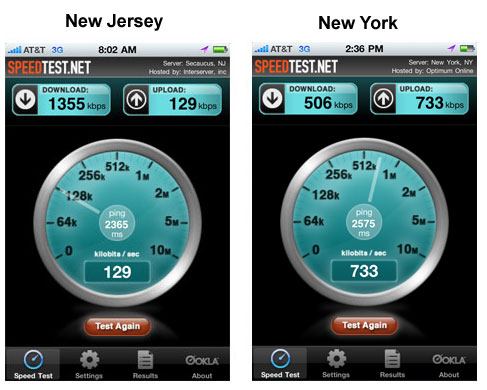
Click to enlarge
On the other hand, the Droid X on Verizon's network had an edge over the iPhone 4 when we tested those two handsets (this time in a central New Jersey home). Motorola's smart phone beat out Apple's on the same sites by 3, 2, and 3 seconds, respectively. That doesn't sound like a lot, but the difference in speed was noticeable. Additionally, the Droid X fits more of a web page on the screen at once; despite the iPhone 4's higher-resolution screen, Safari's menu bar wastes a lot of screen real estate. On a couple of occasions in different locations the iPhone 4 timed out while trying to load a page, which we chalk up to AT&T's iPhone-saturated network.

Click to enlarge

Click to enlarge
Bookmarks and web searches are naturally easy to manage, but we wouldn't mind seeing Apple providing the same tiled view of our favorite sites as the iPad.
The biggest drawback of the iPhone 4 when it comes to the web is that you can only share its data connection via USB or Bluetooth. We'd much prefer a mobile hotspot app, available on both the Evo 4G and Droid X.
Maps and GPS
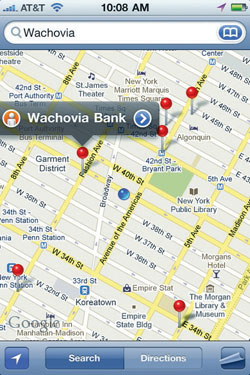
Click to enlargeIt's kind of ironic that the iPhone 4 does a better job with maps than Google even though Apple uses Google's data, at least when it comes to getting your bearings. We much prefer Apple's real-time spotlight that shows you which direction you're heading to Android's little arrow. We also like that the search box is always present, although you can quickly launch one on Android phones with the push of a button.
However, Android has a huge advantage when it comes to GPS navigation because it includes free turn-by-turn directions. The iOS doesn't offer that capability. You'll find some low-cost options in the App Store, but the best solutions from TomTom ($59) and Navigon ($79) cost a pretty penny. The good news is that iOS now allows for navigation apps to run in the background.
FaceTime Video Chat

Click to enlargeThe iPhone 4 certainly isn't the first smart phone to feature a front-facing camera for video calls, but it delivers better quality than the Evo 4G. Setting up a call couldn't be easier. Just dial a contact, and if they own an iPhone 4 you tap the FaceTime option to connect. In just a few seconds you'll see the other caller's face in QVGA resolution. Or press the little switch camera icon to change the view to the iPhone 4's back camera. With this option engaged you can show the other caller what you see, whether it's something your child just learned to do or a new pair of shoes.
Despite some slight stuttering in the stream, we'd say the quality was on a par with an average notebook webcam, which is no small feat given that we're talking about a smart phone. Unfortunately, you can't yet make calls over 3G, though Apple says it is working with carriers, and unlike Fring for Android (which works with Skype) you can't have phone-to-PC calls. We'd like Apple to integrate FaceTime into iChat, and the company says it hopes to make this technology an open standard for other service providers. Over time, we can definitely see FaceTime taking on more functionality, such as sharing pictures by dragging and dropping items onto the other caller's photo.
Camera and Camcorder
We won't mince words: the Flip is pretty much toast. But let's talk about the stunning photo quality first. Instead of piling on the megapixels like other smart phone makers, Apple decided to up the resolution from 3 to 5 megapixels and focus on making images brighter without the need for a flash (though there's finally one on board). That's because Apple equipped its latest device with a backside-illuminated sensor.

Click to enlarge
The difference in quality between the iPhone 4 and iPhone 3GS was astonishing when we took the same picture of a tree at dusk. While the older iPhone struggled to capture the last bits of sunlight, the iPhone 4 delivered amazing detail. That quality gap widened when we snapped the same gum ball container in our kitchen. The 3GS photo looked grainy, while the iPhone 4 did a fantastic job rendering colors.

Click to enlarge

Click to enlarge
When we tried the same shot with the Droid X, it needed to engage its flash and still couldn't match the iPhone 4's crispness and color depth. Apple's device was also noticeably faster, though to be fair the Droid X needs to process more pixels (8 vs. 5). Just don't expect much from the 5X digital zoom.
The iPhone 4 maintains the same advantage over the competition indoors when shooting video. While the 720p footage both it and the Droid X captured of midtown Manhattan was pretty evenly matched, the iPhone 4 leaped ahead of Motorola's phone when we shot the same scene in our conference room. Both the conference table and our talking subject looked clearer and brighter, with much less digital noise. Sound quality was also superior. Too bad you can't output that video to a TV easily via HDMI (like the Evo 4G or Droid X) or DLNA (Droid X).
Want to edit your video on the fly? Check out the $4.99 iMovie app, which lets you pick a theme and add titles right on the phone.
Specs and Performance
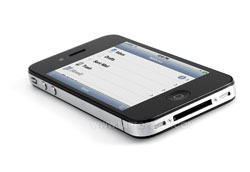
Click to enlargeGiven that the "S" in the iPhone 3GS was supposed to stand for speed, you'd think Apple wouldn't make performance much of a priority this time around. You'd be wrong. And that's because, thanks to the new iOS 4, the iPhone 4 is designed to juggle multiple applications and switch between them quickly. With Apple's A4 processor under the hood (based on ARM and rumored to run 800 MHz) paired with 512MB of RAM (double the 3GS), this handset flies. For example, the camera on the iPhone 4 opened and was ready to fire almost two seconds faster than the 3GS. And unlike the Droid X, the iPhone 4 never stuttered when switching between home screens (although the former has more data on them).
Apple offers two versions of the iPhone 4, one with 16GB ($199) of internal memory and one with 32GB ($299). If you have the means, opt for the latter, especially if you're going to be recording a lot of 720p video and don't want to worry about dumping the footage more often.
The iPhone 4 has another cutting-edge piece of hardware under the hood: a gyroscope. Unlike an accelerometer, this three-axis gyroscope can sense things such as rotation and acceleration, enabling more precise control in games as well as enhanced augmented reality apps.
iOS 4 and Interface

Click to enlargeiOS 4 is optimized for (limited) multitasking and includes other welcome improvements. We say limited because Apple allows only certain activities to occur in the background, and developers need to optimize their apps to take advantage. Still, we love that we can now stream Pandora while, say, browsing the web. Switching between apps is a cinch (double press the Home button and then swipe left or right), but closing apps involves more steps than we'd like (double press Home button, long press on app, than click the minus sign).
Another hallmark feature of iOS 4 is Folders, which you can easily create just by dragging one app on top of another. This cuts down on clutter, and the software cleverly names the folders for you based on the type of app (Business, Games, Utilities, etc.) When it comes to e-mail, we like how easy it is to toggle inboxes and threaded messaging to more easily follow conversations.
Overall, iOS 4 is more robust and flexible than previous iPhone software, but some may prefer Android. While the latter isn't as elegant, you can customize the interface more with everything from social networking widgets to shortcuts to your favorite people.
This time it's personal. No, we're not referring to the increasingly testy rivalry between Apple and Google's multiplying Android army. We're talking about how much more personal a communicator the iPhone 4 is relative to its predecessor. For the first time ever you can have face-to-face video chats (though for now only with other iPhone 4 owners), and Apple has so vastly improved the camera on its handheld that you'll think twice about using that pocket-size digicam or camcorder to record precious memories. Even the relationship between you and your content--whether it's the stuff you record, apps, websites, or iTunes videos--feels more personal, thanks to the ultra-sharp Retina display on this device.
When you consider that the iPhone 4 is also the thinnest smart phone on the market and it offers a considerably beefier battery than the iPhone 3GS, it's hard to find fault with this sequel. Or is it? Monster-size competitors like the Evo 4G and Droid X are breathing down Apple's neck, and one can't ignore AT&T's overtaxed network. Despite some flaws, the iPhone 4 does enough to stay slightly ahead of the superphone pack.
Design
Not only is the iPhone 4 a vast departure from the 3GS' bulbous plastic backside, it's also the antithesis of the big Android slabs that have suddenly become all the rage. In fact, the two-tone black-and-silver design looks like a very slim and elegant pocket camera. And we mean slim. At 0.37 inches, no other smart phone on the market has a sleeker profile. The iPhone 4 is also thinner and narrower than the 3GS, though both devices weigh the same 4.8 ounces.
While devices like the HTC Evo 4G and Motorola Droid X have sturdy and functional industrial designs, we wouldn't call them sexy. The iPhone 4, by contrast, screams luxury; between the chemically hardened glass and little touches like how the light reflects off the ridges of the stainless steel band, this device looks and feels more expensive than its price tag intimates.
This silver band, which Apple claims is forged to be five time stronger than standard steel, wraps around the whole phone. On top you'll find the power button, 3.5mm headphone jack, and one of two microphones (used for FaceTime calls and suppressing noise). The second mic (for voice calls, memos, and voice commands) is on the bottom along with the speaker and dock connector. A ringer switch and two circular volume controls line the left side, and the hole to access the micro-SIM Card is on the right. The black chassis (white coming soon) has a glossy but classy look and houses the 5-megapixel camera and LED flash.

Click to enlarge
Too bad Apple didn't see fit to include a dedicated camera button for launching the app and taking photos. You can't even program a shortcut for double tapping the Home button, as that's now reserved for multitasking/switching apps. You also won't find an HDMI port, which would make it much easier to share the HD footage you record with the iPhone 4's camera on a big-screen TV. (Here's hoping Apple or someone else launches an HDMI dock.)
Retina Display
While other smart phone makers are touting larger displays that display more information at once or Super AMOLED technology that's tailor-made for outdoor readability, Apple went a different direction with the iPhone 4. Its Retina display (so named because the company claims that consumers can't distinguish individual pixels) emphasizes clarity and pixels per inch. In fact, this handset's 960 x 640-pixel, 326 dpi screen doubles that of the iPhone 3GS. While the Droid X's display is nearly an inch larger (4.3 inches), it has a lower resolution of 854 x 480 pixels.
The end result is that text reads as if you were out of a magazine, an effect enhanced by the fact that everything from photos to webpages appear as if they're painted on top of the display. IPS technology (found on the iPad) delivers superb viewing angles, putting the 3GS and most other smart phones to shame.
Now, the effect isn't exactly mind-blowing, but we could definitely notice the difference when we had the same New York Times page and weather widget displayed on the iPhone 4 and its predecessor. Text was much sharper, and we could make out more detail in the two same Flickr photos of the Eiffel Tower.
App developers have already started to write or re-write applications for the iPhone 4's Retina display, including Twitter and EA Sports' NCAA Football (even the logos seem to jump off the screen). Having said all that, there are some benefits to a larger-screen device. For example, we were able to make out more text on The New York Times homepage on the 4.3-inch Evo 4G without needing to zoom in, and watching movies and TV shows is a more immersive experience (despite the narrower viewing angles).
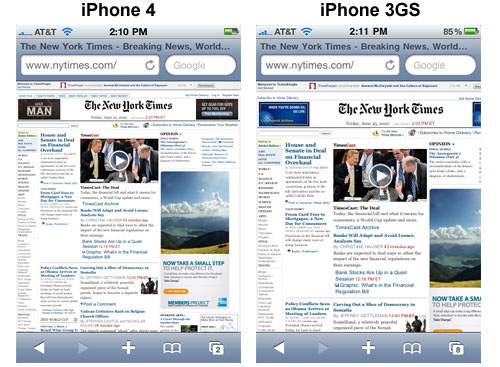
Click to enlarge
Apple iPhone 4 Specs
| Audio formats supported | AAX, WAV, AAC, MP3, HE-AAC, Audible, Apple Lossless, AIFF |
| Bluetooth Type | Bluetooth 2.1 EDR |
| Brand | Apple |
| CPU | 1-GHz Apple A4 |
| Camera Resolution | 5 MP |
| Carrier | AT&T |
| Company Website | http://www.apple.com |
| Data | EDGE/HSPDA |
| Display (main) | 3.5 inches (960 x 640) |
| Display (secondary) | N/A |
| Form Factor | Candybar Touchscreen |
| GPS | Yes |
| Internal Memory | 32GB |
| Memory Expansion Type | N/A |
| Networks | UMTS/HSDPA/HSUPA (800, 900, 1900, 2100 MHz) GSM/EDGE (850, 900, 1800, 1900 MHz) |
| Operating System | iOS 4 |
| Ports | 3.5mm headphone |
| RAM | 512MB |
| Size | 4.5 x 2.3 x 0.4 |
| Talk / Standby Time | Talk time: up to 7 hours (3G) Standby time: up to 12.5 days |
| Video formats supported | MPEG-4, MPEG-4, MP4, MOV, M4V, H.264, AVI |
| Weight | 4.8 ounces |
| Wi-Fi | 802.11b/g/n |

